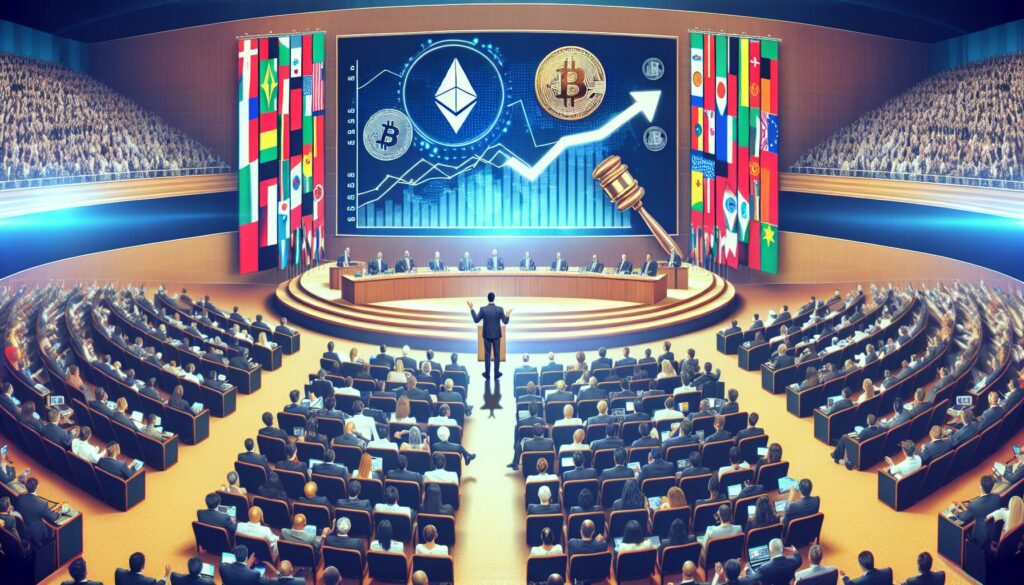As the cryptocurrency landscape takes its turn in the spotlight, Asia is waking up to a wave of significant market movements and geopolitical developments. Bitcoin (BTC) is currently trading above the notable $100,500 mark, suggesting a recovery from weekend volatility triggered by the U.S. military strike on Iranian nuclear facilities. Initially, market reactions saw BTC dip below the six-figure threshold, but as the dust settles, traders appear to have regained their footing.
Traditional markets echo this sentiment, with equity futures remaining flat and gold showing only slight increases, indicating a cautious approach from investors amidst ongoing global tensions. The potential for an escalation in the Strait of Hormuz, a vital conduit for oil shipments, has kept crude oil prices buoyant, nearing $76 per barrel after a notable spike.
Meanwhile, in the cryptocurrency sector, several altcoins such as Ethereum (ETH), XRP, and Solana (SOL) are beginning to recover their losses, following BTC’s lead. Analysts maintain that Bitcoin’s bull market structure remains intact, provided it holds steady above the critical support level of $85,000. Liquidity indicators reveal buying activity near $95,000, while the technical resistance sits at the pivotal $100,000 threshold.
“The market is treating the U.S.-Iran clash as a geopolitical flashpoint, rather than a fundamental threat to stability in the crypto markets,” an analyst noted.
In corporate developments, crypto exchange OKX is reportedly eyeing a public listing strategy in the U.S., which could signify growing confidence in the digital assets sector. This follows its recent expansion efforts after resolving regulatory issues with the Department of Justice. Across the board, the appetite for cryptocurrency-related businesses appears to be on the rise.
Additionally, data from Polymarket shows a diminishing belief among bettors regarding the likelihood of a second U.S. strike on Iran by month’s end, highlighting a potentially shifting narrative toward diplomacy and de-escalation.
As we navigate through a pivotal week in both the cryptocurrency and broader financial markets, the evolving landscape is one to watch closely, with new developments likely to serve as catalysts for traders and investors alike.

Good Morning, Asia: Market Insights
Key points from today’s market briefing:
- Bitcoin Trading: BTC is trading above $100,500 after volatility due to U.S. military actions in Iran, indicating resilience in the crypto market.
- Market Stability: Despite initial dips, markets have stabilized and expectations suggest any Iranian response may be controlled, impacting investor sentiment.
- Crude Oil Prices: Oil prices remain around $76 per barrel, influenced by fears of geopolitical escalations; a potential blockage of the Strait of Hormuz could affect global oil shipments.
- Institutional Interest: Increased buying interest in BTC and other cryptocurrencies indicates a bullish outlook, maintaining price stability at critical support levels.
- OKX IPO Consideration: The crypto exchange OKX is exploring a U.S. IPO, reflecting growing interest in digital asset companies which could impact investment and market dynamics.
- Polymarket Trends: Market sentiment regarding further U.S. military action against Iran is cooling, showcasing a shift towards diplomatic resolutions.
The developments in geopolitical tensions are closely intertwined with market reactions, influencing trading behavior in both traditional and crypto markets, affecting investors’ strategies and outlooks.
Market Impact Analysis: U.S.-Iran Relations and Cryptocurrency Trends
The latest movements in global markets have brought a fascinating mix of volatility and opportunity, particularly in the cryptocurrency space amidst ongoing geopolitical tensions. As Bitcoin crosses the $100,000 threshold while fluctuating due to U.S. strikes in Iran, it exemplifies how external factors can profoundly influence digital asset trading. This consistent price resilience highlights Bitcoin’s potential as a safe haven amid uncertainty, contrasting sharply with traditional markets that remain hesitant.
Competitive Advantages: For cryptocurrency exchanges like OKX, the potential public listing in the U.S. presents an exciting competitive edge. Market enthusiasm for digital assets is growing, encouraging investors and stakeholders to seek exposure through reputable platforms. With BTC’s price holding steady and a solid support system around the $85,000 mark, the overall positive bullish sentiment suggests a thriving environment for such exchanges. Additionally, the stabilization of altcoins like ETH, XRP, and SOL indicates a recovery pattern as traders become more optimistic following initial panic.
Disadvantages: Conversely, the geopolitical climate poses an inherent risk. Investors may face uncertainty, causing some to shy away from the volatile crypto market. The tumultuous reactions often lead to rapid price dips, which may deter new entrants. As the situation develops, exchanges must tread carefully to manage investor sentiment while navigating regulatory challenges, particularly as U.S. attention on crypto compliance intensifies.
Institutional investors could greatly benefit from these dynamics. With strong institutional buying interest in Bitcoin, dollar-cost averaging strategies may emerge as favorable approaches amid market fluctuations. However, for retail investors or less risk-tolerant players, the current state of affairs may present more challenges than opportunities, especially if traditional markets take a dive in reaction to further geopolitical developments.
Continued monitoring of U.S.-Iran relations is essential, as any escalation could lead to heightened market volatility, impacting strategies across both cryptocurrency and traditional asset classes. As geopolitical tensions ebb and flow, the market may remain in a delicate balance between speculative growth and cautious retreat, making adaptability key for traders and investors alike.

















